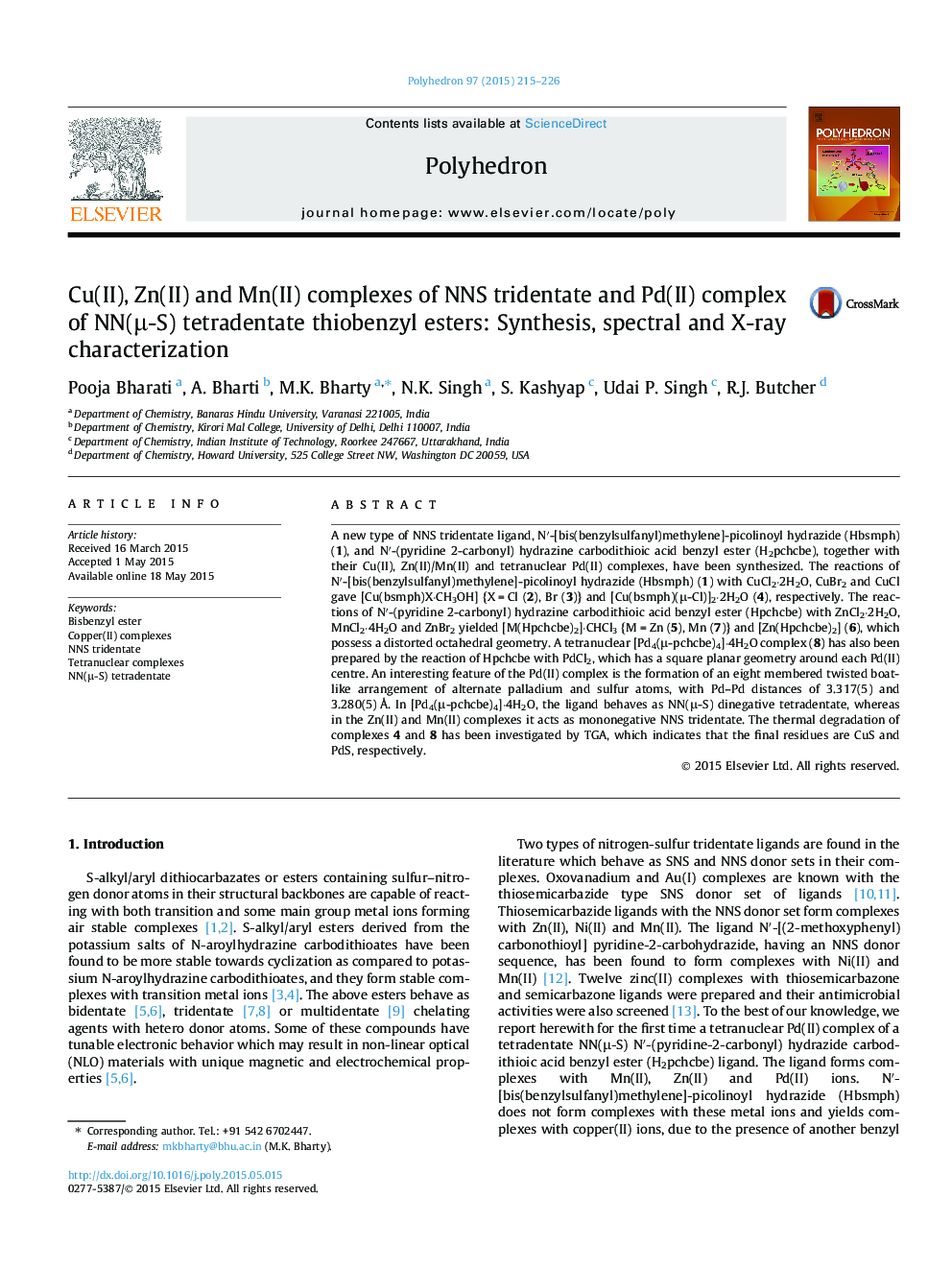| Article ID | Journal | Published Year | Pages | File Type |
|---|---|---|---|---|
| 1335208 | Polyhedron | 2015 | 12 Pages |
A new type of NNS tridentate ligand, N′-[bis(benzylsulfanyl)methylene]-picolinoyl hydrazide (Hbsmph) (1), and N′-(pyridine 2-carbonyl) hydrazine carbodithioic acid benzyl ester (H2pchcbe), together with their Cu(II), Zn(II)/Mn(II) and tetranuclear Pd(II) complexes, have been synthesized. The reactions of N′-[bis(benzylsulfanyl)methylene]-picolinoyl hydrazide (Hbsmph) (1) with CuCl2·2H2O, CuBr2 and CuCl gave [Cu(bsmph)X·CH3OH] {X = Cl (2), Br (3)} and [Cu(bsmph)(μ-Cl)]2·2H2O (4), respectively. The reactions of N′-(pyridine 2-carbonyl) hydrazine carbodithioic acid benzyl ester (Hpchcbe) with ZnCl2·2H2O, MnCl2·4H2O and ZnBr2 yielded [M(Hpchcbe)2]·CHCl3 {M = Zn (5), Mn (7)} and [Zn(Hpchcbe)2] (6), which possess a distorted octahedral geometry. A tetranuclear [Pd4(μ-pchcbe)4]·4H2O complex (8) has also been prepared by the reaction of Hpchcbe with PdCl2, which has a square planar geometry around each Pd(II) centre. An interesting feature of the Pd(II) complex is the formation of an eight membered twisted boat-like arrangement of alternate palladium and sulfur atoms, with Pd–Pd distances of 3.317(5) and 3.280(5) Å. In [Pd4(μ-pchcbe)4]·4H2O, the ligand behaves as NN(μ-S) dinegative tetradentate, whereas in the Zn(II) and Mn(II) complexes it acts as mononegative NNS tridentate. The thermal degradation of complexes 4 and 8 has been investigated by TGA, which indicates that the final residues are CuS and PdS, respectively.
Graphical abstractThe NNS tridentate ligands N′-[bis(benzylsulfanyl)methylene]-picolinoyl hydrazide (Hbsmph) (1) and N′-(pyridine 2-carbonyl) hydrazine carbodithioic acid benzyl ester (H2pchcbe) and their Cu(II), Zn(II)/Mn(II) and tetranuclear Pd(II) complexes have been synthesized and characterized by various physicochemical techniques. The reactions of N′-[bis(benzylsulfanyl)methylene]-picolinoyl hydrazide (Hbsmph) (1) with CuCl2·2H2O, CuBr2 and CuCl gave [Cu(bsmph)X·CH3OH] {X = Cl(2), Br(3)} and [Cu(bsmph)(μ-Cl)]2·2H2O (4) respectively which are mononuclear and dinuclear five coordinate, possessing a square pyramidal geometry. The reactions of N′-(pyridine 2-carbonyl) hydrazine carbodithioic acid benzyl ester (Hpchcbe) with ZnCl2·2H2O, MnCl2·4H2O and ZnBr2 yielded [M(Hpchcbe)2]·CHCl3 {M = Zn(5), Mn(7)} and [Zn(Hpchcbe)2] (6) which have a distorted octahedral geometry. The tetranuclear Pd(II) [Pd4(μ-pchcbe)4]·4H2O (8) complex has also been prepared by the reaction of Hpchcbe with PdCl2, which has a square planar geometry around each Pd(II) centre. The thermal degradation of complexes 4 and 8 have been investigated by TGA, which indicates that the final residues are CuS and PdS, respectively.Figure optionsDownload full-size imageDownload as PowerPoint slide
